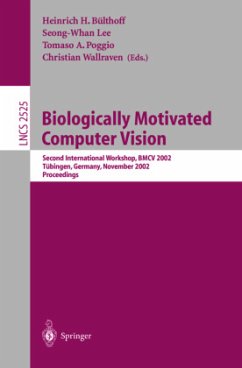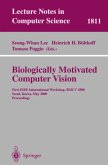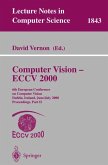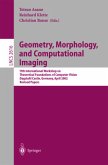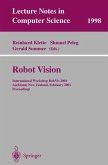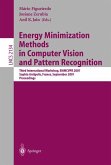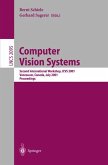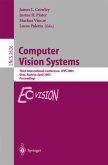Heinrich H. Bülthoff / Seong-Whan Lee / Tomaso Poggio / Christian Wallraven (eds.)Second International Workshop, BMCV 2002, Tübingen, Germany, November 22-24, 2002, Proceedings
Biologically Motivated Computer Vision
Second International Workshop, BMCV 2002, Tübingen, Germany, November 22-24, 2002, Proceedings
Herausgegeben:Bülthoff, Heinrich H.; Lee, Seong-Whan; Poggio, Tomaso; Wallraven, Christian
Heinrich H. Bülthoff / Seong-Whan Lee / Tomaso Poggio / Christian Wallraven (eds.)Second International Workshop, BMCV 2002, Tübingen, Germany, November 22-24, 2002, Proceedings
Biologically Motivated Computer Vision
Second International Workshop, BMCV 2002, Tübingen, Germany, November 22-24, 2002, Proceedings
Herausgegeben:Bülthoff, Heinrich H.; Lee, Seong-Whan; Poggio, Tomaso; Wallraven, Christian
- Broschiertes Buch
- Merkliste
- Auf die Merkliste
- Bewerten Bewerten
- Teilen
- Produkt teilen
- Produkterinnerung
- Produkterinnerung
This book constitutes the refereed proceedings of the Second International Workshop on Biologically Motivated Computer Vision, BMCV 2002, held in Tübingen, Germany, in November 2002. The 22 revised full papers and 37 revised short papers presented together with 6 invited papers were carefully reviewed and selected from 97 submissions. The papers are organized in topical sections on neurons and features, motion, mid-level vision, recognition - from scenes to neurons, attention, robotics, and cognitive vision.
Andere Kunden interessierten sich auch für
![Biologically Motivated Computer Vision Biologically Motivated Computer Vision]() Seong-Whang Lee / Heinrich H. Bülthoff / Tomaso Poggio (eds.)Biologically Motivated Computer Vision77,99 €
Seong-Whang Lee / Heinrich H. Bülthoff / Tomaso Poggio (eds.)Biologically Motivated Computer Vision77,99 €![Computer Vision - ECCV 2000 Computer Vision - ECCV 2000]() David Vernon (ed.)Computer Vision - ECCV 200078,99 €
David Vernon (ed.)Computer Vision - ECCV 200078,99 €![Geometry, Morphology, and Computational Imaging Geometry, Morphology, and Computational Imaging]() Tetsuo Asano / Reinhard Klette / Christian Ronse (eds.)Geometry, Morphology, and Computational Imaging39,99 €
Tetsuo Asano / Reinhard Klette / Christian Ronse (eds.)Geometry, Morphology, and Computational Imaging39,99 €![Robot Vision Robot Vision]() Reinhard Klette / Shmuel Peleg / Gerald Sommer (eds.)Robot Vision39,99 €
Reinhard Klette / Shmuel Peleg / Gerald Sommer (eds.)Robot Vision39,99 €![Energy Minimization Methods in Computer Vision and Pattern Recognition Energy Minimization Methods in Computer Vision and Pattern Recognition]() Mario A.T. Figueiredo / Josiane Zerubia / Anil K. Jain (eds.)Energy Minimization Methods in Computer Vision and Pattern Recognition78,99 €
Mario A.T. Figueiredo / Josiane Zerubia / Anil K. Jain (eds.)Energy Minimization Methods in Computer Vision and Pattern Recognition78,99 €![Computer Vision Systems Computer Vision Systems]() Bernt Schiele / Gerhard Sagerer (eds.)Computer Vision Systems39,99 €
Bernt Schiele / Gerhard Sagerer (eds.)Computer Vision Systems39,99 €![Computer Vision Systems Computer Vision Systems]() James Crowley / Justus Piater / Markus Vincze / Lucas Paletta (eds.)Computer Vision Systems77,99 €
James Crowley / Justus Piater / Markus Vincze / Lucas Paletta (eds.)Computer Vision Systems77,99 €-
-
-
This book constitutes the refereed proceedings of the Second International Workshop on Biologically Motivated Computer Vision, BMCV 2002, held in Tübingen, Germany, in November 2002.
The 22 revised full papers and 37 revised short papers presented together with 6 invited papers were carefully reviewed and selected from 97 submissions. The papers are organized in topical sections on neurons and features, motion, mid-level vision, recognition - from scenes to neurons, attention, robotics, and cognitive vision.
The 22 revised full papers and 37 revised short papers presented together with 6 invited papers were carefully reviewed and selected from 97 submissions. The papers are organized in topical sections on neurons and features, motion, mid-level vision, recognition - from scenes to neurons, attention, robotics, and cognitive vision.
Produktdetails
- Produktdetails
- Lecture Notes in Computer Science 2525
- Verlag: Springer / Springer Berlin Heidelberg / Springer, Berlin
- Artikelnr. des Verlages: 978-3-540-00174-4
- 2002
- Seitenzahl: 684
- Erscheinungstermin: 13. November 2002
- Englisch
- Abmessung: 235mm x 155mm x 37mm
- Gewicht: 1142g
- ISBN-13: 9783540001744
- ISBN-10: 3540001743
- Artikelnr.: 23386497
- Herstellerkennzeichnung Die Herstellerinformationen sind derzeit nicht verfügbar.
- Lecture Notes in Computer Science 2525
- Verlag: Springer / Springer Berlin Heidelberg / Springer, Berlin
- Artikelnr. des Verlages: 978-3-540-00174-4
- 2002
- Seitenzahl: 684
- Erscheinungstermin: 13. November 2002
- Englisch
- Abmessung: 235mm x 155mm x 37mm
- Gewicht: 1142g
- ISBN-13: 9783540001744
- ISBN-10: 3540001743
- Artikelnr.: 23386497
- Herstellerkennzeichnung Die Herstellerinformationen sind derzeit nicht verfügbar.
Heinrich H. Bülthoff, Max Planck Institute for Biological Cybernetics, Tubingen, Germany / Seong-Whan Lee, Korea University, Seoul, Korea / Tomaso Poggio, Massachusetts Institute of Technology, Cambridge, Massachusetts, USA / Christian Wallraven, Max Planck Institute for Biological Cybernetics, Tubingen, Germany
Neurons and Features.- Ultra-Rapid Scene Categorization with a Wave of Spikes.- A Biologically Motivated Scheme for Robust Junction Detection.- Iterative Tuning of Simple Cells for Contrast Invariant Edge Enhancement.- How the Spatial Filters of Area V1 Can Be Used for a Nearly Ideal Edge Detection.- Improved Contour Detection by Non-classical Receptive Field Inhibition.- Contour Detection by Synchronization of Integrate-and-Fire Neurons.- Reading Speed and Superiority of Right Visual Field on Foveated Vision.- A Model of Contour Integration in Early Visual Cortex.- Computational Cortical Cell Models for Continuity and Texture.- A Neural Model of Human Texture Processing: Texture Segmentation vs. Visual Search.- Unsupervised Image Segmentation Using a Colony of Cooperating Ants.- Image Reconstruction from Gabor Magnitudes.- A Binocular Stereo Algorithm for Log-Polar Foveated Systems.- Rotation-Invariant Optical Flow by Gaze-Depended Retino-Cortical Mapping.- An Analysis of the Motion Signal Distributions Emerging from Locomotion through a Natural Environment.- Motion.- Prototypes of Biological Movements in Brains and Machines.- Insect-Inspired Estimation of Self-Motion.- Tracking through Optical Snow.- On Computing Visual Flows with Boundaries: The Case of Shading and Edges.- Biological Motion of Speech.- Mid-Level Vision.- Object Perception: Generative Image Models and Bayesian Inference.- The Role of Propagation and Medial Geometry in Human Vision.- Ecological Statistics of Contour Grouping.- Statistics of Second Order Multi-modal Feature Events and Their Exploitation in Biological and Artificial Visual Systems.- Recognition -From Scenes to Neurons.- Qualitative Representations for Recognition.- Scene-Centered Description from Spatial Envelope Properties.- Visual Categorization: How the Monkey Brain Does It.- A New Approach towards Vision Suggested by Biologically Realistic Neural Microcircuit Models.- Interpreting LOC Cell Responses.- Neural Mechanisms of Visual Flow Integration and Segregation -Insights from the Pinna-Brelsta. Illusion and Variations of It.- Reconstruction of Subjective Surfaces from Occlusion Cues.- Extraction of Object Representations from Stereo Image Sequences Utilizing Statistical and Deterministic Regularities in Visual Data.- A Method of Extracting Objects of Interest with Possible Broad Application in Computer Vision.- Medical Ultrasound Image Similarity Measurement by Human Visual System (HVS) Modelling.- Seeing People in the Dark: Face Recognition in Infrared Images.- Modeling Insect Compound Eyes: Space-Variant Spherical Vision.- Facial and Eye Gaze Detection.- 1-Click Learning of Object Models for Recognition.- On the Role of Object-Specific Features for Real World Object Recognition in Biological Vision.- Object Detection in Natural Scenes by Feedback.- Stochastic Guided Search Model for Search Asymmetries in Visual Search Tasks.- Biologically Inspired Saliency Map Model for Bottom-up Visual Attention.- Hierarchical Selectivity for Object-Based Visual Attention.- Attention.- Attending to Motion: Localizing and Classifying Motion Patterns in Image Sequences.- A Goal Oriented Attention Guidance Model.- Visual Attention Using Game Theory.- Attentional Selection for Object Recognition - A Gentle Way.- Audio-Oculomotor Transformation.- Gender Classification of Human Faces.- Face Reconstruction from Partial Information Based on a Morphable Face Model.- Dynamics of Face Categorization.- Recognizing Expressions by Direct Estimation of the Parameters of a Pixel Morphable Model.- Modeling of MovementSequences Based on Hierarchical Spatial-Temporal Correspondence of Movement Primitives.- Automatic Synthesis of Sequences of Human Movements by Linear Combination of Learned Example Patterns.- An Adaptive Hierarchical Model of the Ventral Visual Pathway Implemented on a Mobile Robot.- A New Robotics Platform for Neuromorphic Vision: Beobots.- Learning to Act on Objects.- Egocentric Direction and the Visual Guidance of Robot Locomotion Background, Theory and Implementation.- Evolving Vision-Based Flying Robots.- Object Detection and Classification for Outdoor Walking Guidance System.- Understanding Human Behaviors Based on Eye-Head-Hand Coordination.- Vision-Based Homing with a Panoramic Stereo Sensor.- Cognitive Vision.- Unsupervised Learning of Visual Structure.- Role of Featural and Configural Information in Familiar and Unfamiliar Face Recognition.- View-Based Recognition of Faces in Man and Machine: Re-visiting Inter-extra-Ortho.
Neurons and Features.- Ultra-Rapid Scene Categorization with a Wave of Spikes.- A Biologically Motivated Scheme for Robust Junction Detection.- Iterative Tuning of Simple Cells for Contrast Invariant Edge Enhancement.- How the Spatial Filters of Area V1 Can Be Used for a Nearly Ideal Edge Detection.- Improved Contour Detection by Non-classical Receptive Field Inhibition.- Contour Detection by Synchronization of Integrate-and-Fire Neurons.- Reading Speed and Superiority of Right Visual Field on Foveated Vision.- A Model of Contour Integration in Early Visual Cortex.- Computational Cortical Cell Models for Continuity and Texture.- A Neural Model of Human Texture Processing: Texture Segmentation vs. Visual Search.- Unsupervised Image Segmentation Using a Colony of Cooperating Ants.- Image Reconstruction from Gabor Magnitudes.- A Binocular Stereo Algorithm for Log-Polar Foveated Systems.- Rotation-Invariant Optical Flow by Gaze-Depended Retino-Cortical Mapping.- An Analysis of the Motion Signal Distributions Emerging from Locomotion through a Natural Environment.- Motion.- Prototypes of Biological Movements in Brains and Machines.- Insect-Inspired Estimation of Self-Motion.- Tracking through Optical Snow.- On Computing Visual Flows with Boundaries: The Case of Shading and Edges.- Biological Motion of Speech.- Mid-Level Vision.- Object Perception: Generative Image Models and Bayesian Inference.- The Role of Propagation and Medial Geometry in Human Vision.- Ecological Statistics of Contour Grouping.- Statistics of Second Order Multi-modal Feature Events and Their Exploitation in Biological and Artificial Visual Systems.- Recognition -From Scenes to Neurons.- Qualitative Representations for Recognition.- Scene-Centered Description from Spatial Envelope Properties.- Visual Categorization: How the Monkey Brain Does It.- A New Approach towards Vision Suggested by Biologically Realistic Neural Microcircuit Models.- Interpreting LOC Cell Responses.- Neural Mechanisms of Visual Flow Integration and Segregation -Insights from the Pinna-Brelsta. Illusion and Variations of It.- Reconstruction of Subjective Surfaces from Occlusion Cues.- Extraction of Object Representations from Stereo Image Sequences Utilizing Statistical and Deterministic Regularities in Visual Data.- A Method of Extracting Objects of Interest with Possible Broad Application in Computer Vision.- Medical Ultrasound Image Similarity Measurement by Human Visual System (HVS) Modelling.- Seeing People in the Dark: Face Recognition in Infrared Images.- Modeling Insect Compound Eyes: Space-Variant Spherical Vision.- Facial and Eye Gaze Detection.- 1-Click Learning of Object Models for Recognition.- On the Role of Object-Specific Features for Real World Object Recognition in Biological Vision.- Object Detection in Natural Scenes by Feedback.- Stochastic Guided Search Model for Search Asymmetries in Visual Search Tasks.- Biologically Inspired Saliency Map Model for Bottom-up Visual Attention.- Hierarchical Selectivity for Object-Based Visual Attention.- Attention.- Attending to Motion: Localizing and Classifying Motion Patterns in Image Sequences.- A Goal Oriented Attention Guidance Model.- Visual Attention Using Game Theory.- Attentional Selection for Object Recognition - A Gentle Way.- Audio-Oculomotor Transformation.- Gender Classification of Human Faces.- Face Reconstruction from Partial Information Based on a Morphable Face Model.- Dynamics of Face Categorization.- Recognizing Expressions by Direct Estimation of the Parameters of a Pixel Morphable Model.- Modeling of MovementSequences Based on Hierarchical Spatial-Temporal Correspondence of Movement Primitives.- Automatic Synthesis of Sequences of Human Movements by Linear Combination of Learned Example Patterns.- An Adaptive Hierarchical Model of the Ventral Visual Pathway Implemented on a Mobile Robot.- A New Robotics Platform for Neuromorphic Vision: Beobots.- Learning to Act on Objects.- Egocentric Direction and the Visual Guidance of Robot Locomotion Background, Theory and Implementation.- Evolving Vision-Based Flying Robots.- Object Detection and Classification for Outdoor Walking Guidance System.- Understanding Human Behaviors Based on Eye-Head-Hand Coordination.- Vision-Based Homing with a Panoramic Stereo Sensor.- Cognitive Vision.- Unsupervised Learning of Visual Structure.- Role of Featural and Configural Information in Familiar and Unfamiliar Face Recognition.- View-Based Recognition of Faces in Man and Machine: Re-visiting Inter-extra-Ortho.

